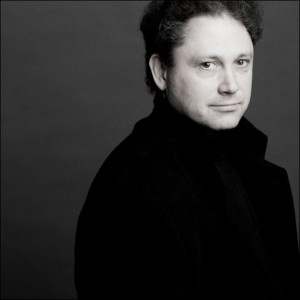Egarr leads H&H in mostly successful Beethoven and Mozart

Richard Egarr conducted the Hancel and Haydn Society Friday night at Symphony Hall. Photo: Marco Borggreve
Convincing performances of Beethoven symphonies don’t always require the heavy firepower of a modern symphony orchestra. For evidence, look to the Handel and Haydn Society, who offered an energetic and lithe reading of Beethoven’s Seventh Symphony Friday night at Symphony Hall.
The long-awaited performance of the Symphony No. 7 in A major did not disappoint as Richard Egarr returned to the H&H to lead the period-instrument orchestra with equal parts punch and sensitivity.
Egarr is an expressive conductor who leads with commanding hammer-like strokes and long sweeping gestures. The symphony’s opening movement danced gracefully under his guide, but the musicians took time to find their bearings with the music. In the slow introduction, triplet figures in the winds tended to overpower the strings. The subsequent Vivace suffered from similar balance problems, though briefly, when the horns got the upper hand of the strings in the full statement of the jig-like theme.
The famous and tragic second movement maintained its drive as Egarr directed the orchestra with a light but deliberate approach. H&H musicians settled into fine balance for the variations that sprung from the bare opening statement.
The remaining movements sparkled with precision. The Scherzo frolicked under Egarr’s hand, and the final movement lit up with almost explosive energy.
To complement the Beethoven, Egarr and company offered two Mozart works with varying success.
The first, Mozart’s Clarinet Concerto K. 622, featured clarinetist Eric Hoeprich in a delicate and sharply-played historical novelty.
Mozart composed the concerto especially for clarinetist Anton Stadler, whose specialty in the clarinet’s lower register led to experiments in instrument development. The basset clarinet, for which Mozart originally conceived the concerto, was a result.
Hoeprich, principal clarinetist for the H&H orchestra and a specialist in historical clarinets, performed on a basset clarinet reproduction he constructed from recently discovered sketches of Stadler’s own instrument. An S-curve design from the mouthpiece to the bulbous-shaped bell, Hoeprich’s basset clarinet, like its Stadler original, extends the clarinet’s lower range and is made from boxwood, which gives the instrument a light, delicate, almost hollow timbre.
The three movements of Mozart’s Clarinet Concerto make ample use of the instrument’s extreme registers, sometimes in punctuated, even pointillistic fashion. To match music to instrument, Hoeprich and the H&H orchestra performed a re-constructed version of the concerto, bringing some of the solo passages into the lower range.
Throughout, Hoeprich played the dexterous passages in the brisk outer movements with crisp, controlled playing, though the basset clarinet’s softer sound in the lower range was sometimes lost in the balance. He performed the second movement’s aria-like melody with delicate feeling and a singing quality, especially in the nimble upper tessitura. The orchestra accompaniment, under Egarr’s hand, swelled to obtain intimate warmth.
That energy and focus was not evident in the orchestra’s rendering of Mozart’s Masonic Funeral Music K. 477.
It didn’t instill confidence that Egarr, in his brief introductory remarks to the audience, humorously described the work as “a five-minute bit of miserable Mozart” (a nod to the music’s brooding nature, but one could not ignore the double entendre).
H&H’s performance was hardly miserable, but, unfortunately, it did not show the orchestra at its best. From the opening bars, the exposed woodwinds and horns wavered in intonation, a basset horn blast in the beginning came off as comic, and the orchestra struggled to line up most of the tutti chords that punctuate the work’s closing measures.
There were moments of fine music—the oboes performed the chant-like melody with stately expression, and the strings answered with elegant phrasing. But one couldn’t escape the feeling that Egarr and the orchestra were simply going through the motions.
Composed in memory of two Viennese aristocrats and fellow Freemasons, Masonic Funeral Music may not be a masterpiece, but it still contains moments of prodding depth. One was left to wonder how the music would have sounded had Egarr and H&H put across the piece with more serious conviction.
To open the concert, associate conductor John Finney led the orchestra and a chorus of high-school students from Brockton, Lawrence, and the Boston Latin School—part of the Educational Outreach Program—in two excerpts from Handel’s Utrecht Te Deum. The well-prepared student singers sang with confidence and an agreeable blend.
The program will repeat 3 p.m. Sunday in Symphony Hall. handelandhaydn.org; 617-262-1815
Posted in Performances